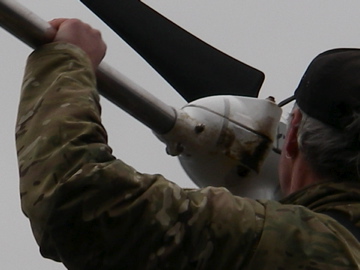We had a “wind drought” recently, a few days when we had no wind. The timing was bad, as my book, Shy Ghosts Dancing, had just hit the bookstores in e-book format, and I had orders to fill, but it did provide an opportunity to do what needed to be done: it was time, once again, to head butt the wind generator.

Assuming the position, preparing to head butt! You can see the smear of washed out lubricant on the generator. (Photo: Aly Zeiger.)
Some readers have asked for more on our power system, but I tend to keep quiet about it, mostly out of superstition. We have a very good wind generator; when it works, it works well, and we depend heavily on the electricity it provides, backed up by a small bank of solar panels. However, there are flaws in the product, and perhaps more importantly, with the company. I live in fear of a new break down, knowing that I’m in trouble when that happens.
The basic problem is that these machines and their peripherals are manufactured on a planet very different from our own. On this planet they don’t have the wind and weather conditions faced by our neighbors, many of whom own the same make and model of generator, and us.
The current example: lubrication on the furling pin. These machines “feather” or “furl” in high gusts, folding the machine on a pivot so that the blades angle away from the wind. It’ll still charge, but the force of the high wind is reduced to safe levels. The pin on which the pivot occurs is precision designed and manufactured. It is lubricated in such a way that it’ll last a lifetime, and should never need maintenance.
Or, so they say. The fact is, whatever their secret lubricant is, it must be water soluble. I can see where it has flowed out of the pivot on my machine, leaving an unsightly smear. As soon as this happens, and it happened soon after I first installed the machine, the generator will get stuck in furling position now and then.
This has happened to almost every neighbor, if not all of them. No one can observe the conditions that cause this; it’s not cold, or heat, or excessive rain, apparently. Any time we cross the bay, where most of the other machines are, we’ll see one or two cocked over in permanent furl every time! After a while, the next gust usually knocks a cocked generator into play again, but we’ve had one case where a machine stuck in furling position literally blew apart. No one who depends on these things for their home’s electricity wants that!
One neighbor shipped his generator back to the company to “fix” it. It stuck within two weeks of getting it back. Since it costs about $100 to send the heavy piece south for work, you can imagine his response.
Because we had a calm, and because having my machine cocked over like that drives me to distraction, I took the time and trouble to install my tower ladder, climb into my safety harness, and climb to the top of the tower. Once there, I knew what to do, because I’ve done it once before: wrapping one leg around the tower, and shortening my harness strap to hold me closer to the tower, I reached up and grabbed the barrel of the generator with one hand, and the tail with the other. Then, I placed my forehead against the machine at the pivot point, and pulled with both hands, “head butting” the machine back into position. I did this several times, testing the machine’s tendency to right itself as designed. The results weren’t encouraging.
Sounds like a lot of work for a “largely maintenance free” system, doesn’t it? To make it more worth my while, I combined this task with another one, which I’ll tell you about next time.
